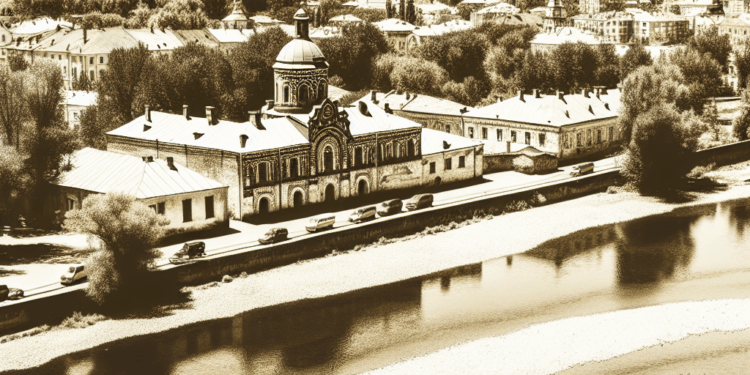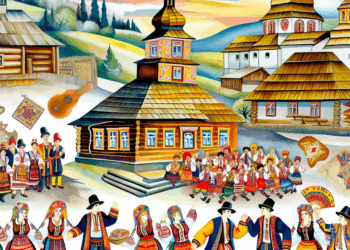Bukovina is a historical region rich in cultural and ethnic traditions. Its history spans many eras and states, including princely times, the Austrian Empire, the interwar years and the Soviet era. This article aims to familiarise the reader with little-known but significant facts from the history of Bukovina.
I. Princely times
1. Origin of the name
The word “Bukovina” comes from the word “beech” (Fagus), which symbolises the forests that cover this region. In early times, the region was inhabited by tribes that left their traces in language and culture. It is important to mention that in documents from the 14th century, the region is mentioned as part of the Principality of Moldavia, which foreshadowed its future destiny.
2. Prince Bogdan I
One of the first and significant rulers mentioned in the history of Bukovina is Prince Bogdan I, who in 1359 became the founder of the Principality of Moldavia. During his reign, active colonisation and land development began. Under his leadership, the territory of Bukovina began to develop actively, and the first fortresses and fortified cities, such as Chernivtsi, appeared here.
3. The western limit of Moldavia
Bukovina served not only as a centre of princely power, but also as a protected western limit of Moldavia. The territory gained special importance during the war with the Ottoman Empire. In 1476, the Moldavian prince Stefan III defeated the Turkish troops at the Battle of Rymnik, which confirmed the protective status of Bukovina.
II. Times of the Austrian Empire
4. Accession to the Austrian Empire
In 1775, after the war with Turkey, Bukovina was annexed by the Austrian Empire. This event was a turning point in the history of the region. The new authorities began to actively develop the economy, infrastructure and education. In particular, many roads and railways were built, which contributed to economic growth.
5. Multinationality of the region
Under Austrian rule, Bukovina became an important cultural and ethnic crossroads. Romanians, Ukrainians, Poles, Jews and Germans coexisted in the region. Each ethnic group contributed to the development of the territory. The linguistic and cultural diversity led to the formation of a unique socio-cultural atmosphere where different traditions intersected.
6. Enlightenment and culture
In the 1860s, an era of national revival began in Bukovina. Thanks to the support of the Austrian government, schools and cultural institutions were opened. The first printing houses started printing books in Romanian and Ukrainian. Famous personalities appeared at this time, such as the writer Yuriy Fedkovych, who became a symbol of cultural revival.
III. Interwar years
7. Autonomous Principality
The post-war events of 1918 led to the formation of a new state – the Kingdom of Romania. Bukovina became part of it, which went down in history as a period of relative autonomy. At this time, the region began to master new forms of self-government; freed from the Austrian order, the local authorities tried to create their own identity.
8. Economic rise
Between the two World Wars, Bukovina experienced an economic boom thanks to agrarian reforms, which primarily concerned the redistribution of land. The improvement of agriculture and the development of industrial enterprises influenced the living standards of local residents.
9. Art and culture
During this period, the economy flourished in Bukovina, as well as the arts. New cultural institutions, theatres and art galleries were built. Especially worth noting is the theatre in Chernivtsi, which became the centre of cultural life in the region. Not only local artists, but also famous musicians and actors from all over the country performed here.
IV. Soviet era
10. Accession to the Soviet Union
In 1940, as a result of treaties with Nazi Germany, Bukovina changed its borders again and was annexed to the Soviet Union. This transition was accompanied by massive repressions and political changes that greatly affected the lives of the local inhabitants.
11. Cultural changes
The Soviet regime brought its own changes to the cultural life of the region. Religious institutions were closed and attempts were made to “de-classify” the population. However, despite this, a period of cultural revival began in the 1950s with the opening of new schools, theatres and libraries.
12. Development of agriculture
After the war, collectivisation was implemented, which changed the structure of local agriculture. Farmers began to organise themselves into collective farms, which, while creating certain social changes, also led to an increase in agricultural production.
13. ethnic relations
Soviet rule introduced and complicated new facets of ethnic relations. Russification and integration changed people’s views on identity again. Many people found themselves in a situation where their ethnicity was questioned against a background of changing political situations and prejudice.
V. Conclusion
The history of Bukovina has remained complex and multi-layered throughout the centuries. Little known facts about princely times, the Austrian era, the interwar years and the Soviet era show that this region was not only a part of major political changes, but also a place of cultural transformation and social dynamics.
While preserving its traditions and identity, Bukovina is entering a new era, continuing to remain at the crossroads of different cultures, languages and histories. Each of the above-mentioned eras has left its mark on the region’s history, which makes the study of its past particularly fascinating.
Thus, researching little-known facts about Bukovina allows us to gain a deeper understanding not only of its unique history, but also of the difficulties and challenges faced by the inhabitants of this region throughout the centuries.








